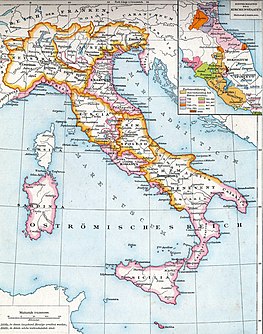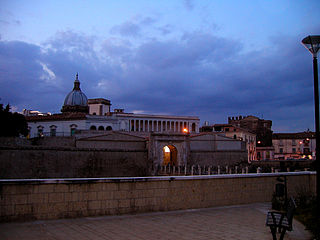
The Lombards or Langobards were a Germanic people who ruled most of the Italian Peninsula from 568 to 774, with origins near the Elbe in northern Germany and Scania in southern Sweden before the Migration Period.

Capua is a city and comune in the province of Caserta, in the region of Campania, southern Italy, situated 25 km (16 mi) north of Naples, on the northeastern edge of the Campanian plain.

The history of Italy in the Middle Ages can be roughly defined as the time between the collapse of the Western Roman Empire and the Italian Renaissance. The term "Middle Ages" itself ultimately derives from the description of the period of "obscurity" in Italian history during the 9th to 11th centuries, the saeculum obscurum or "Dark Age" of the Roman papacy as seen from the perspective of the 14th to 15th century Italian Humanists.

The Duchy of Benevento was the southernmost Lombard duchy in the Italian Peninsula that was centred on Benevento, a city in Southern Italy. Lombard dukes ruled Benevento from 571 to 1077, when it was conquered by the Normans for four years before it was given to the Pope. Being cut off from the rest of the Lombard possessions by the papal Duchy of Rome, Benevento was practically independent from the start. Only during the reigns of Grimoald, King of the Lombards and the kings from Liutprand on was the duchy closely tied to the kingdom. After the fall of the kingdom, however, it was the sole Lombard territory to continue to exist as a rump state, maintaining its de facto independence for nearly 300 years, although it was divided after 849.

Pandulf I Ironhead was the Prince of Benevento and Capua from 943 until his death. He was made Duke of Spoleto and Camerino in 967 and succeeded as Prince of Salerno in 977 or 978. He was an important nobleman in the fight with the Byzantines and Saracens for control of the Mezzogiorno in the centuries after the collapse of Lombard and Carolingian authority on the Italian Peninsula. He established himself over almost the whole of the southern half of Italia before his death in March 981.

Arechis II was a Duke of Benevento, in Southern Italy. He sought to expand the Beneventos' influence into areas of Italy that were still under Byzantine control, but he also had to defend against Charlemagne, who had conquered northern Italy.
Radelchis I was the treasurer, then prince of Benevento from 839, when he assumed the throne upon the assassination of Sicard and imprisonment of Sicard's brother, Siconulf, to his death, though in his time the principality was divided.
Landulf IV was the prince of Capua and Benevento from 968, when he was associated with his father, Pandulf Ironhead, and prince of Salerno associated with his father from 977 or 978. In 968, his uncle Landulf III died and this was the occasion of his rise, as Pandulf ignored the rights of Landulf's son Pandulf, his nephew, and instead associated his own son with the government.
Lando I was the count of Capua from 843. He was the eldest son and successor of Landulf the Old. Like his father, he supported Siconulf against Radelchis in the civil war dividing the Principality of Benevento in the 840s.
Sergius I was the first duke of Naples of his dynasty, often dubbed the "Sergi," which ruled over Naples for almost three centuries from his accession in 840 until the death of his namesake Sergius VII in 1137.

The Lombard Principality of Salerno was a Southern Italian state, formed in 851 out of the Principality of Benevento after a decade-long civil war. It was centred on the port city of Salerno. Although it owed allegiance at its foundation to the Carolingian emperor, it was de facto independent throughout its history and alternated its allegiance between the Carolingians and their successors in the West and the Byzantine emperors in the east.
The Principality of Capua was a Lombard state centred on Capua in Southern Italy, usually de facto independent, but under the varying suzerainty of Holy Roman and Eastern Roman Empires. It was originally a gastaldate, then a county, within the principality of Salerno.

The Norman conquest of southern Italy lasted from 999 to 1139, involving many battles and independent conquerors.
The Landulfids or Atenulfings were a noble family of Lombardic origin in the ninth through eleventh centuries. They were descended from Landulf I of Capua, whose own ancestry is unknown and who died in 843. The dynasty produced a line of princes which ruled most of southern Italy at one time or another and even one pope, Victor III.
The Emirate of Bari was a short-lived Islamic state in Apulia ruled by non-Arabs, probably Berbers and Black Africans. Controlled from the South Italian city of Bari, it was established about 847 when the region was taken from the Byzantine empire, but fell in 871 to the army of Emperor Louis II.

Pontecorvo is a town and comune in the province of Frosinone, Lazio, Italy. Its population is c. 13,200.

The Frankish emperor Louis II campaigned against the Emirate of Bari continuously from 866 until 871. Louis was allied with the Lombards of southern Italy from the start, but an attempt at joint action with the Byzantine Empire failed in 869. In the final siege of the city of Bari in 871, Louis was assisted by a Slavic fleet from across the Adriatic.

The Siege of Salerno was one of the campaigns of the Aghlabids in southern Italy during their conquest of Sicily. The Lombard city of Salerno had strong defences and, despite the use of stone-throwing artillery, the siege lasted a little over a year from its beginning in late 871 or early 872. Prince Guaifer of Salerno led the defence, but the siege was only lifted by the arrival of an army of Lombards and Franks under the Emperor Louis II.











